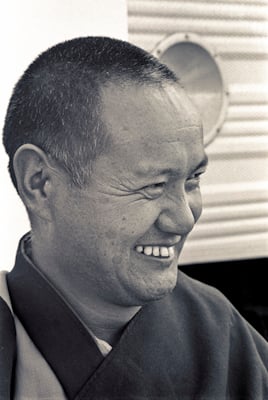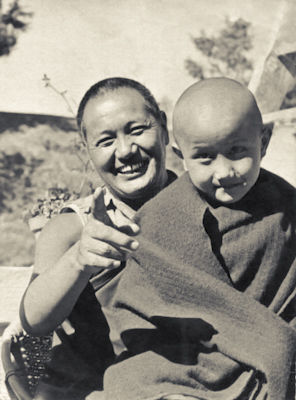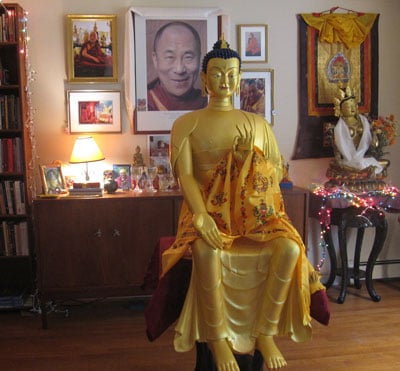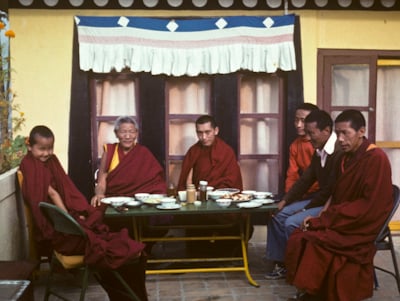Dear LYWA friends and supporters,
Welcome to our one hundredth e-letter! And thank you so much for having helped make it happen. As you know, it’s only with your support that we’re able to archive and publish the teachings of Lama Yeshe and Lama Zopa Rinpoche and we’re so grateful for all the help you have given us over the years.
 We have over 600,000 books in print, most of them for free distribution, and thousands of pages of teachings and hundreds of hours of audio freely available on our website. Our online image gallery is growing by leaps and bounds, our eBooks are also taking off and we are making rare archival video of our Lamas’ teachings accessible on DVD. So this is a moment to celebrate and rejoice over all we have accomplished—together. Like I said, we couldn’t do it without you. So thank you again.
We have over 600,000 books in print, most of them for free distribution, and thousands of pages of teachings and hundreds of hours of audio freely available on our website. Our online image gallery is growing by leaps and bounds, our eBooks are also taking off and we are making rare archival video of our Lamas’ teachings accessible on DVD. So this is a moment to celebrate and rejoice over all we have accomplished—together. Like I said, we couldn’t do it without you. So thank you again.
Appeal Update
Our midyear appeal finishes this month and we fell well short of our target, but we continue to press ahead with the many projects we have in the pipeline.
Our Publishing the FPMT Lineage project, several years in the development stages, will soon be bearing fruit. We hope to publish at least six books of Lama Zopa Rinpoche’s lamrim commentaries over the next eighteen months. Our new Heart Advice Series is also coming along and we expect to publish Rinpoche’s slightly-delayed Bodhisattva Attitude soon. Work on Big Love, Adele Hulse’s official biography of Lama Yeshe, also proceeds apace and we’re looking at a 2012 publication date. And Rinpoche’s Vajrayogini commentary and a book of his nyung nä teachings are also well advanced.
So, a huge thank you to all who have contributed to our current appeal. It’s still not too late to do so if you’d be so kind. Thank you.
What's New in Our Image Gallery
 View more amazing photos from 1976 in our Online Image Gallery. Over the past few months we have posted two series of photos from this very active year of travel and teaching by the lamas. This will be the 3rd volume, with pictures from Kopan that year including:
View more amazing photos from 1976 in our Online Image Gallery. Over the past few months we have posted two series of photos from this very active year of travel and teaching by the lamas. This will be the 3rd volume, with pictures from Kopan that year including:
• Many pictures of the western Sangha;
• Pictures of a young Yangsi Rinpoche;
• Pictures of Lama Zopa Rinpoche giving teachings at the 9th Kopan Lamrim course; and
• Group photos of the attendees of the 9th course.
You can read the entire course transcript from the 9th Kopan Course here.
What Else is New on Our Website
Speaking of Kopan courses, we have just posted the entire course transcript from the 10th Kopan Course in 1977. You can read and search the transcripts online, or download the entire course as a pdf file to read offline.
There were 13 new advices added to Rinpoche's Online Advice Book this past month. Included in the new advices were Rinpoche's Practice Advice for a Newly Ordained Monk; Rinpoche's answer to a student who asked what practices he should do to quickly achieve enlightenment for the sake of all mother sentient beings; and a compilation of Rinpoche's advices regarding the use of Dharma images on t-shirts.
A Call for Volunteers
LYWA is looking for experienced Dharma students to help us with adding keywords (or "tags") to teachings on our website. It's a great excuse to spend time reading Dharma! At the same time you'll be helping make the teachings more accessible to other website visitors.
We are also looking for long-time students who have attended many teachings with Rinpoche and have little difficulty understanding his speech to check transcripts. This involves listening to recordings and reading along with the first draft of the transcript and making updates to smooth it out. Good writing and editing skills and familiarity with Microsoft Word required.
If you are interested in either of these volunteer positions please send an email to [email protected].
The Future is Now The future buddha, Maitreya, came to LYWA this summer, courtesy of the Maitreya Project.
The future buddha, Maitreya, came to LYWA this summer, courtesy of the Maitreya Project.
It was the great wish of Lama Yeshe and remains the great wish of Kyabje Lama Zopa Rinpoche to build a large version of this magnificent statue in India, and work toward fulfilling their holy wishes continues apace. All details are on Project’s website.
As you can see, this life-size replica Maitreya statue looks amazing in the LYWA library/shrine room!
The Maitreya Project is making these statues available to all. Lama Zopa Rinpoche has recommended that each FPMT center get one of these statues, but many individuals have also done so, as you can see from the quotes on the statue link. We highly recommend it, too!
Death and Rebirth
As many of you have already heard, Khensur Rinpoche Lama Lhundrup passed away at Kopan Monastery on September 7th. Lama Lhundrup arrived at Kopan Monastery to teach the young monks at Lama Yeshe’s request in 1973. He was acting abbot from 1984 to 2001, when he was officially appointed abbot and remained in that position until two months before his death. Lama Lhundrup will be sorely missed by his students at Kopan and all over the world. For more information about the life and death of this great lama, see the FPMT website.
This past weekend His Holiness released a statement concerning the issue of his reincarnation. It includes a discussion of past and future lives, rebirth, and the system of recognizing reincarnations in Tibet, as well as His Holiness's reflections on his own reincarnation. Check it out.
Thank you again for all your kind support of our work. We leave you with an excerpt from our forthcoming book in our Publishing the FPMT Lineage series, How to Practice Dharma: The Eight Worldly Dharmas.
Much love,
Nick Ribush
Director
This Month's Teaching: The Eight Worldly Dharmas: Gain and Loss
 To like something doesn’t always mean being attached to it, but if we think of the material possessions we most treasure—money, cars, jewels and so forth—we’ll probably see the strong attachment we have for them. And this is true of not just objects but friends as well. When we meet friends we feel a kind of pleasure and completely believe that it’s real, true pleasure and don’t recognize that there’s attachment there as well.
To like something doesn’t always mean being attached to it, but if we think of the material possessions we most treasure—money, cars, jewels and so forth—we’ll probably see the strong attachment we have for them. And this is true of not just objects but friends as well. When we meet friends we feel a kind of pleasure and completely believe that it’s real, true pleasure and don’t recognize that there’s attachment there as well.
We think that we receive real happiness from our friends or our precious objects but that mind of attachment is confused. The temporal happiness we get from attachment is not true happiness; it does not arise by diminishing desire but by following it, by making friends with desire.
Furthermore, whenever there’s attachment there’s fear of losing the object of attachment, and the stronger the attachment, the stronger the fear. If it’s a material object, we always have to keep it in safe place and lock all the doors. Even if it never gets stolen or lost, we’re constantly afraid it will be. If it’s a friend, the greater our attachment the more worried we are that he or she might leave us.
With strong attachment, even if we live in a very luxurious house, wear very expensive clothes and eat delicious food, life has little taste. Our body is there but our mind is not happy. The greater our attachment to the four desirable objects, the greater our worry about meeting the four undesirable objects. And when we meet those undesirable objects we don’t know what to do. Our life gets completely confused and we go crazy; perhaps we even see suicide as the only escape from our suffering.
We have the constant, nagging worry that the four undesirable objects are waiting for us just around the corner. They might not exist for us now—we haven’t met the object of dislike yet and might in fact never meet it—but in our mind it’s as if the problem were already there. And when something really happens to an object we cherish—it gets lost or destroyed or our friend leaves us—then the more our attachment, the greater our suffering. We get incredibly upset, our mood plummets into depression and our whole face completely changes.
Think about some precious object to which you’re attached. Do you have any anxiety about its being lost, stolen or destroyed? Even though you have that object and are never separated from it, even though that hasn’t happened yet, are you still afraid that it will? Visualize that precious object or that precious friend. Visualize the object being destroyed or your friend dying and imagine how you’d feel, how it would affect your mind.
Let’s say that we have a bowl to which we are very attached, whether it’s a valuable antique or just an old cracked Tibetan one. One day we break it. Our mind gets incredibly upset; we become inconsolably unhappy. If we’d been less attached to the bowl, we’d suffer much less at its loss. On the other hand, if somebody steals our garbage, we’re not worried at all; it doesn’t shake our mind. Without attachment, losing our garbage doesn’t cause our mood to plummet. Of course, it’s always possible that there are people who are attached to their garbage and would be upset if it were stolen.
If we compare our lack of attachment to garbage to our attachment to a precious object and compare our lack of suffering at the loss of one to our intense suffering at the loss of the other, we can easily see that our suffering comes from attachment, not the loss of the object.
Whenever there’s the thought of the worldly dharmas—clinging to shelter, food, clothing and so forth—there’s worry and fear about losing them. Whenever there’s attachment to comfort, there’s fear of losing it; whenever there’s attachment to receiving material things, there’s fear of not receiving them; whenever there’s attachment to praise, there’s fear of being criticized; whenever there’s attachment to a good reputation, there’s fear of receiving a bad one. That’s the fundamental suffering. Not having the four desirable objects is suffering, but so is having them and, because of attachment, being afraid of losing them.
We’re in samsara so of course we can’t always possess the objects of our desire. We’re constantly looking for the four desirable objects but more often meeting the four undesirable ones. This is not a new experience; in fact it has been going on forever. The antiquities in a museum are absolutely nothing compared to this. No matter how old they might be, they originated after this world system started and we can still count their age in centuries or millennia. Our experience of meeting undesirable objects, on the other hand, started long before our current rebirth, even long before this world was created, and as we’re still not free from samsara we’ll continue to meet undesirable things for as long as we’re in it. That is the nature of our samsaric life.
As long as we rely on external objects such as consumer goods and praise for our happiness, we’ll never find stability. The external world is always changing, so our reaction to it always changes too, up and down all the time—the sun shines, happy; the rain comes, unhappy; praise, happy; criticism, unhappy; good program on television, happy; boring program, unhappy. Whenever the conditions change our mind changes along with them, up and down, up and down, constantly.
Say it’s Christmas and there’s somebody who’s usually very generous and always gives us a nice present. We come to expect presents from her, so when we see her our mind suddenly gets lifted up. That’s a sign that we’re attached to receiving material things. Then, one Christmas, for some reason she doesn’t give us a present. We get confused. We make up all sorts of reasons for why she has neglected us and strong dislike for her arises in our mind. We complain to her face that she loves everybody but us. We shout at and criticize her. Perhaps we even spit in her face. If we’re sitting at the table having dinner, even before we’ve finished eating, we hurl our plate to the floor, stamp our feet, run from the room to our bedroom and slam the door shut so loudly that everybody can hear. Then we throw ourselves onto our bed crying and complaining, criticizing her over and over, like a mantra. For hours and hours we recite the criticizing mantra. Thinking how she loves everybody else so much more, we get completely depressed and generate incredible anger toward this friend and jealousy toward everybody else. This is the work of the thought of the eight worldly dharmas.
With clinging, it seems that when we’re in the middle of bad times they’ll never end, but when there’s no clinging we can see that it’s not like that. If something unpleasant is happening, it doesn’t bother us so much. If we cut off the desire clinging to this life through such basic techniques as meditating on impermanence and death, then even if the four undesirable things happen, it’s no big deal.
We might have huge problems in our life—nobody in our family loves us, everybody hates us, we have to go to court and it looks as if we might have to spend the rest of our life in prison, we have a very bad reputation and everybody gossips about us, wherever we go in the street or at home everybody criticizes and refuses to help us—and in our mind it might appear that this is going to last forever, as if it’s permanent, but in reality this life is over in a flash. It’s like lightning; it happens, then it’s gone.
While the lightning is there we can see the objects around us vividly, then suddenly that appearance disappears. The appearance of this life is the same; it happens, then suddenly it’s gone. Compared to our beginningless past lives, this life lasts just a second, like lightning.
Lama Tsongkhapa says that this life is as impermanent as a water bubble, gone in a second. Seeing this, we should strive to take the essence of this perfect human rebirth and let go of clinging completely.
Excerpted from the forthcoming book How to Practice Dharma: The Eight Worldly Dharmas, edited by Gordon McDougall, due out later in 2011.





























